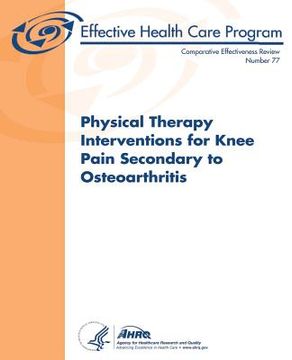Physical Therapy Interventions for Knee Pain Secondary to Osteoarthritis: Comparative Effectiveness Review Number 77 (en Inglés)
Reseña del libro "Physical Therapy Interventions for Knee Pain Secondary to Osteoarthritis: Comparative Effectiveness Review Number 77 (en Inglés)"
Osteoarthritis (OA), the most common form of arthritis, is a progressive joint disorder characterized by gradual loss of cartilage. Osteoarthritis of the knee afflicts 28 % of adults over age 45 and 37 % of adults over age 65 in the U.S. As a leading cause of disability among noninstitutionalized adults, OA's prevalence, effect on health, and economic consequences are expected to increase dramatically during the next few decades as the population ages. OA treatments aim to reduce or control pain, improve physical function, prevent disability, and enhance quality of life. Conservative treatment options include pain relievers, anti-inflammatory drugs, weight loss, general physical exercise, and physical therapy. Optimal OA management combines pharmacologic treatments with physical therapy interventions and, when conservative treatments fail, surgery. Surgical treatments for knee OA include realignment osteotomy and knee replacements. In the U.S., about 556,400 knee replacement surgeries are performed annually. By 2030, that number is projected to increase by 600 %. Comprehensive, up-to-date guidelines are available from the Osteoarthritis Research Society International (OARSI), the American Academy of Orthopedic Surgeons, and the National Institute for Health and Clinical Excellence. These guidelines recommend exercise as a core treatment for symptomatic osteoarthritis, regardless of patient age, comorbidity, pain severity, or disability. Effectiveness has not been clearly established for other nonpharmacologic physical therapy interventions as adjunct to core treatment (e.g., thermal, manipulation, electrical nerve stimulation, and orthotics). This report synthesizes published evidence about the effectiveness of physical therapy for pain secondary to knee OA in adults. For the topic of physical therapy interventions for adults with knee OA, our goal was to conduct (1) a comprehensive review of the literature about the association between intermediate and patient-centered outcomes and (2) a comprehensive synthesis of evidence of the clinical efficacy and comparative effectiveness of the interventions. We followed the principles from the Methods Guide for Effectiveness and Comparative Effectiveness Reviews from AHRQ. We examined the following questions: Key Question 1. What are the effectiveness and comparative effectiveness of available physical therapy interventions (without drug treatment) for adult patients with chronic knee pain due to OA on intermediate and patient centered outcomes when compared to no active treatment or another active physical therapy modality? a. Which patient characteristics are associated with the benefits of examined interventions of physical therapy on intermediate and patient-centered outcomes? b. Do changes in intermediate and patient-centered outcomes differ by the dose, duration, intensity, and frequency of examined interventions of physical therapy? c. Do changes in intermediate and patient-centered outcomes differ by the time of followup? Key Question 2. What is the association between changes in intermediate outcomes with changes in patient-centered outcomes after physical therapy interventions? a. What is the validity of the tests and measures used to determine intermediate outcomes of physical therapy on knee OA in association with patient-centered outcomes? b. Which intermediate outcomes meet the criteria of surrogates for patient-centered outcomes? c. What are the minimum clinically important differences of the tests and measures used to determine intermediate outcomes? Key Question 3. What are the harms from physical therapy interventions available for adult patients with chronic knee pain due to osteoarthritis when compared to no active treatment or active controls? a. Which patient characteristics are associated with the harms of examined physical therapy interventions? b. Do harms differ by the duration of the treatment and time of followup?

